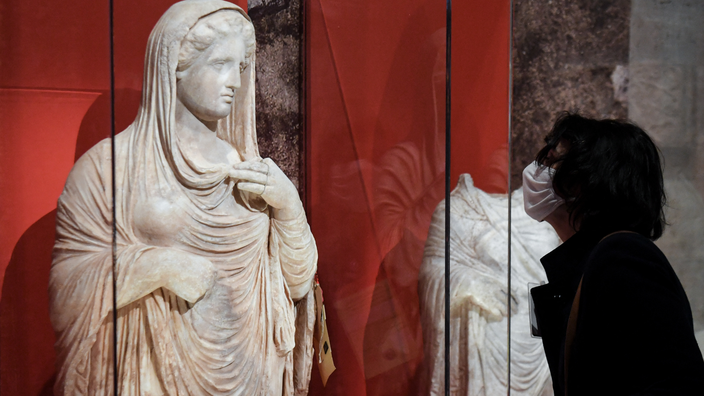The mysterious allure of the goddess Persephone calls out to visitors.
Draped in her marble veil, the Queen of the Underworld is represented by four ancient sculptures, alongside a handful of busts and bas-reliefs from the Near East.
Aligned in the antiques wing of the Louvre, these antiques stand out: with their waxed judicial seals, they are the subject of a small exhibition intended to highlight the worldwide ravages of trafficking in cultural goods.
Read also: Half a century after being stolen, frescoes from the region of Pompeii back under Vesuvius
Showing such works,
"it's a great first"
in France, told AFP Ludovic Laugier, curator at the Department of Greek, Etruscan and Roman Antiquities at the Louvre.
Thanks to a 2016 law revising the heritage code, investigating judges gave their authorization to expose them, while their investigation continues to trace the networks responsible for their looting.
Objective: to warn about the misdeeds of the illicit trade in cultural goods, a traffic which generates nearly 10 billion dollars per year, according to the latest estimates by Unesco.
"We must show these works to make them unsaleable
"
Behind the sculptures presented at the Louvre, seized in 2012 at Roissy airport, the wall is covered with an aerial view of the necropolis of Cyrene, one of the largest ancient cities in North Africa. These half-funerary statues had most likely watched over tombs from Roman times in present-day eastern Libya for over 2,000 years, before the greed of the traffickers tore them from their archaeological context. The Middle East, plagued by numerous conflicts, is among the first victims of this crime, which is as low risk as it is lucrative. Beyond the destruction of the ancient cities of Palmyra and Amapée in Syria, or Hatra and Nimrud in Iraq, the jihadist group Daesh isis for example largely financed thanks to the resale of what experts call
“blood antiques”
.
A bas-relief from late Antiquity, possibly looted in Syria, intercepted by French customs.
ALAIN JOCARD / AFP
Faced with this scourge, raising awareness among the general public makes it possible
"to play on demand"
, hopes Ludovic Laugier.
"The more people doubt, check the provenance, the less demand there is for stolen antiques and the less supply."
"You have to show these works to make them unsaleable, in the same way that the Mona Lisa is unsaleable because everyone knows her"
, insists Vincent Michel, archaeologist specializing in the classical East, engaged in the fight against trafficking.
The busts of Persephone on display are
"easy to recognize"
, continues the head of the French archaeological mission in Libya.
These funerary statues were produced by the thousands in Cyrene and its surroundings, between the 6th and 1st centuries BC.
J.-C .. Their marble strewn with reddish traces is typical of the
terra rossa
of the region.
Read also: The sulphurous Bible museum in Washington returns thousands of missing antiquities to Egypt
To sharpen their eyes, visitors can scan QR codes scattered on the walls, allowing them to access various "red lists" such as those of Interpol or the International Council of Museums (ICOM), which list stolen goods or documents. categories of works highly prized by traffickers. Tracing the history of antiquities, however, often proves more difficult, as the two bas-reliefs also shown in this exhibition attest. Covered with Christian crosses and interlacing of vines, they probably come from Syria, but traffic has made them
“silent”
, regrets Ludovic Laugier: impossible to date them or to recontextualize them precisely. Seized in 2016 at Roissy airport,they had been registered in Lebanon as
"garden ornaments"
to Thailand. This illustrates the complexity of globalized traffic, tracked down by two services in France: the Central Office for the Fight against Trafficking in Cultural Goods (OCBC) and customs.
Before returning the goods to their country of origin,
"the investigations can be long because we have to call on international cooperation and often go up a chain of multiple intermediaries"
, explains Corinne Cléostrate, Deputy Director of Customs in charge of legal affairs. and the fight against fraud. In addition to these organized networks, traffic is also worsening with the Covid-19 pandemic.
"We are witnessing a kind of industrialization of looting"
, worries Vincent Michel. In countries in conflict where the coronavirus has further impoverished the population, poorly guarded archaeological sites, whose antiques can now be resold in a few clicks on social networks, represent a tempting financial windfall.
“You really have to realize that behind an antique, there may be an offense,”
concludes the archaeologist. The exhibition is on display in the Vivant Denon wing of the Louvre until December 13.

